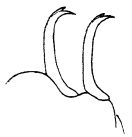Genus description from Pilato & Beasley 1987: “hind legs reduced to short stumps lacking claws. First three pairs of legs with two single claws. Bucco-pharyngeal apparatus with the buccal tube provided with the ventral strengthening bar. Mouth without peribuccal lamellae, provided with 6 peribuccal papulae and 6 peribuccal lobes. Pharyngeal bulb provided with apophyses and placoids.”



Citations:
Pilato G, Beasley CW. 1987. Haplohexapodibius seductor n. gen. n. sp. (Eutardigrada Calohypsibiidae) with remarks on the systematic position of the new genus. Animalia. 14: 65-71.















